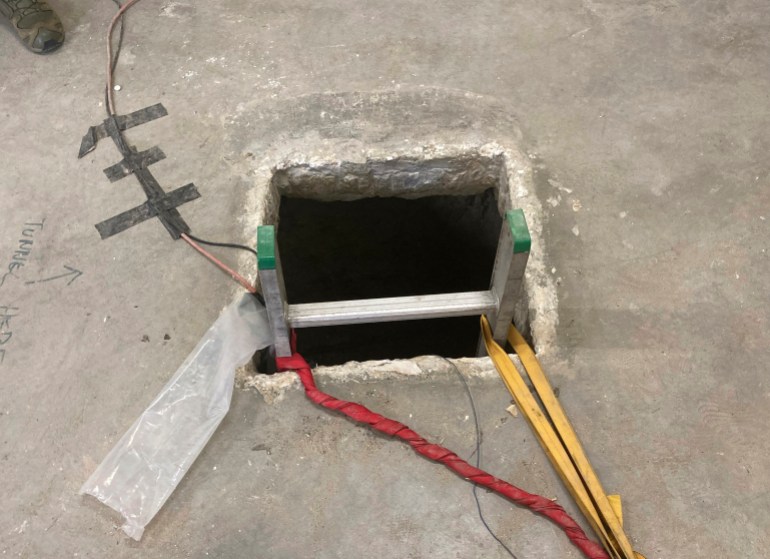US authorities find major cross-border ‘narco-tunnel’ to Mexico
Tunnel from Tijuana to San Diego had rail and ventilation systems, electricity and reinforced walls, authorities say.

Authorities in the United States have announced the discovery of a major drug smuggling tunnel that extends from Mexico to a warehouse in an industrial area in the US state of California.
The secret passage from Tijuana to San Diego featured rail and ventilation systems, electricity and reinforced walls, authorities said on Tuesday.
Keep reading
list of 3 itemsMexico: Women march to demand justice, answers for disappeared
US delegation travelling to Mexico to discuss upcoming summit
It was discovered near San Diego’s Otay Mesa border crossing in an area where more than a dozen other sophisticated tunnels have been found in the last two decades.
US authorities said it was unknown how long the tunnel had been operating and what amount of drugs, if any, got through undetected. They seized 799kg (1,761 pounds) of cocaine, 75kg (165 pounds) of methamphetamine and 1.6kg (3.5 pounds) of heroin in connection with the investigation.
Six southern California residents, aged 31 to 55, were charged with conspiring to distribute cocaine.
“Together with the Mexican government we have been collaborating in trying to eradicate these tunnels, which should not exist because that is where a lot of crime happens, and a lot of the suffering that we see,” US Ambassador to Mexico Ken Salazar told the Spanish-language weekly Zeta.
“This needs to stop,” he said.

The latest passage, discovered on Friday, ran 532 metres to the Mexican border city of Tijuana. It was about six storeys deep.
The tunnel is in one of the most fortified stretches of the border, illustrating the limitations of border walls. While considered effective against small, crudely built tunnels called “gopher holes”, walls are no match for more sophisticated passages that run deeper underground.
Former US President Donald Trump campaigned on a promise to build a border wall along the US-Mexico border that he said would keep migrants and crime at bay. President Joe Biden, who took office in January last year, fulfilled his own campaign promise and stopped border-wall construction on his first day in office.
The discovery comes as the US is preparing to lift a controversial pandemic-era border restriction that turned back most people trying to seek asylum at the border with Mexico. Republican-led states have responded by suing the Biden administration, arguing that the decision will encourage more migration to the US and lead to a rise in crime.
It also comes amid strained relations between the US and Mexico over the upcoming Summit of the Americas, which the US is set to convene in Los Angeles next month.
Last week, Mexico’s President Andres Manuel Lopez Obrador said if the Biden administration excludes Cuba, Nicaragua and Venezuela from the summit, he would not attend and send a representative instead.
The tunnel discovered by American authorities exited into the US in a nondescript warehouse named “Amistad Park”, located on a street that is busy with large semitrailers during the day but quiet at night.

After staking out a home that was recently used to stash drugs, officials began making traffic stops of vehicles that had been there or at a warehouse near the border, turning up boxes full of cocaine, according to a federal criminal complaint filed in San Diego.
They raided the properties — finding no other drugs at the warehouse, but the tunnel opening carved into the cement floor, federal prosecutors said.
On Monday, armed guards watched over a small shaft with a ladder that descended into the tunnel.
The type of drugs seized may signal a shift from the multi-tonne loads of cannabis or marijuana that were often found in discoveries before California legalised cannabis for recreational use in 2019.
Hard drugs, such as heroin, methamphetamine and fentanyl, are typically smuggled through official border crossings from Mexico because their small size and lack of odour make them difficult to detect. But tunnels give smugglers the advantage of being able to carry huge loads at lightning speed.
Authorities have found about 15 sophisticated tunnels on California’s border with Mexico since 2006.
Officials declined to link the latest tunnel to any specific cartel.
“There is no more light at the end of this narco-tunnel,” said Randy Grossman, US attorney for the Southern District of California. “We will take down every subterranean smuggling route we find to keep illicit drugs from reaching our streets and destroying our families and communities.”
Under federal law, US authorities must fill the American side of such tunnels with concrete after they are discovered.